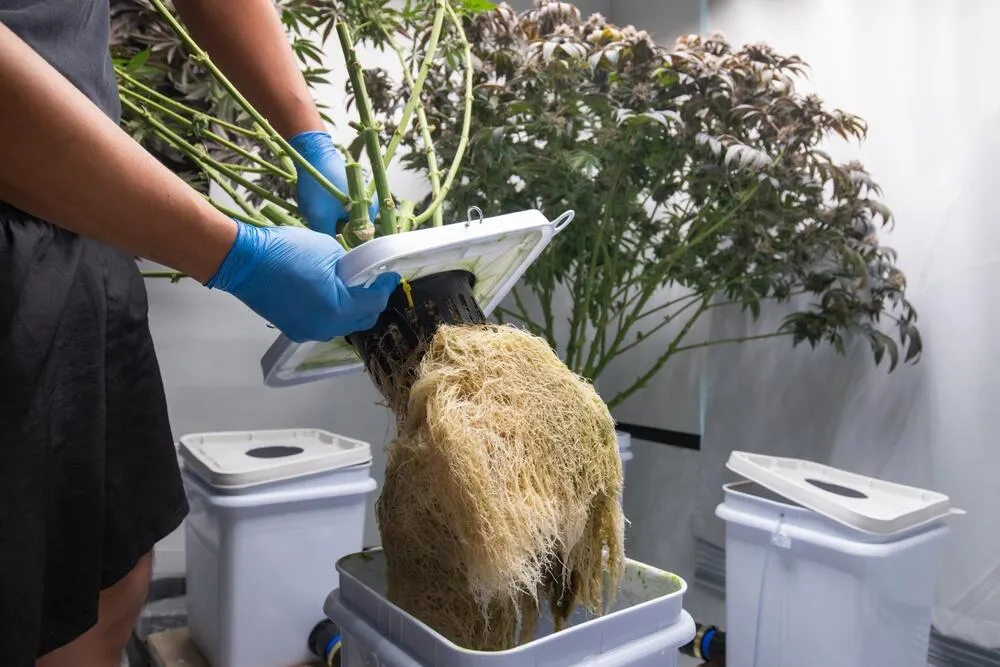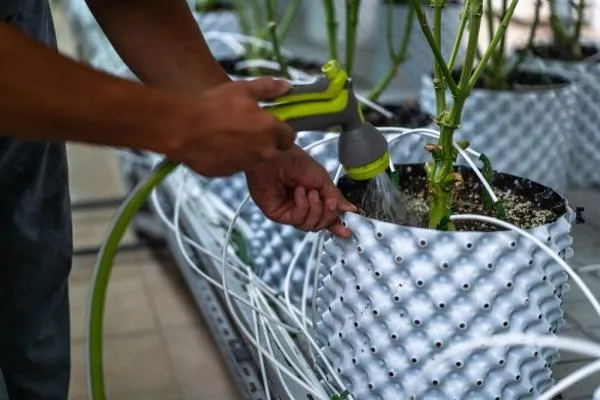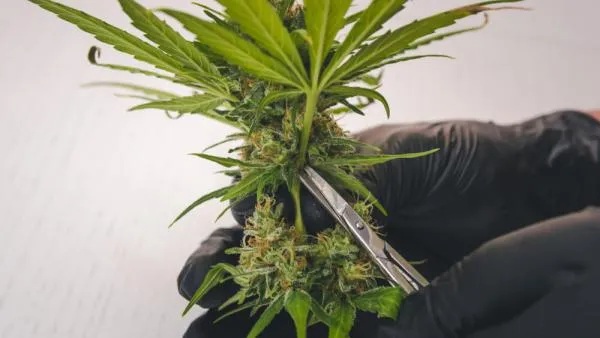What is Root Rot on Cannabis?
Root rot is a sneaky problem that affects the roots of your cannabis plants, and it’s more common than you might think. Essentially, it’s when the roots start decaying due to excess moisture, lack of oxygen, or fungal infections. Once root rot takes hold, your plants struggle to absorb nutrients and water, leading to yellow leaves, stunted growth, and even death. Knowing what root rot is and how it impacts your plants is the first step in tackling it.
Causes of root rot in cannabis plants
Root rot typically happens when your plants’ roots are sitting in water for too long. This can occur because of poor soil drainage, overwatering, or even a lack of air circulation in the root zone. The stagnant environment creates the perfect conditions for fungal pathogens like Pythium to thrive.
How to identify root rot in cannabis
Identifying root rot early is key. Look out for roots that are slimy, brown, or smelly instead of their usual firm and white appearance. Above ground, you might notice yellowing leaves, drooping stems, and slow growth. The plant might also look like it’s wilting, even though you’ve watered it recently.
The impact of root rot on plant health
Root rot can have devastating effects on your cannabis plants. Without healthy roots, your plant can’t take in the nutrients or water it needs to grow strong and produce quality buds. Left untreated, root rot spreads quickly and can lead to the entire plant dying.
Common Causes of Root Rot in Cannabis Plants
Overwatering and poor soil drainage
Overwatering is one of the biggest culprits of root rot. When soil stays soggy, it cuts off oxygen to the roots, creating a swampy environment. Combine this with soil that doesn’t drain well, and you’ve got a recipe for disaster.
Lack of root zone aeration
Roots need oxygen to function properly. If the soil or growing medium is too compacted or waterlogged, the roots suffocate. This is especially a problem in hydroponic systems without proper air pumps or aerators.
The role of fungal pathogens in root rot
Fungal pathogens, like Pythium, are a major player in root rot. They thrive in wet, oxygen-poor conditions and attack the roots, causing them to decay. Once these fungi get a foothold, they spread quickly, making it harder to save your plants.
Pythium infection and its effects
Pythium, often called water mold, is notorious for causing root rot. It invades the roots, turning them slimy and brown. As it spreads, it weakens the plant’s ability to take up water and nutrients, leading to visible signs of stress and decline.
How to Prevent Root Rot in Cannabis Plants

Tips for maintaining healthy root systems
Healthy roots are your first line of defense against root rot. Make sure your plants have the right balance of water, oxygen, and nutrients. Regularly inspect the roots for signs of trouble and address any issues promptly.
Best practices for soil drainage
Good soil drainage is a game-changer. Use a well-aerated soil mix with additives like perlite or coco coir to improve drainage. Ensure your pots have adequate drainage holes to let excess water escape.
The importance of aeration in hydroponics
In hydroponics, proper aeration is a must. Use air stones or pumps to keep the water oxygenated and prevent it from becoming stagnant. This simple step can help keep root rot at bay.
Choosing the right soil for cannabis growth
Pick a soil that’s light and airy, with good drainage properties. Avoid soils that retain too much water, as they can create the perfect environment for root rot to develop.
Watering schedules to avoid overwatering
Stick to a watering schedule that matches your plant’s needs. Check the soil moisture with your finger or a moisture meter before watering. Remember, it’s better to underwater slightly than to overwater.
How to Fix Root Rot on Cannabis Plants
Recognizing early signs of root rot
Catching root rot early can save your plants. Pay attention to signs like drooping leaves, slow growth, and discolored roots. The sooner you act, the better your chances of recovery.
- Leaves drooping or wilting even after watering
- Roots turning slimy, brown, or giving off a bad smell
- Yellowing or discoloration of the plant’s foliage
- Stunted growth or slowed overall development
- Soil or growing medium staying excessively wet
Steps to treat root discoloration
To treat discolored roots, start by gently removing the affected plant from its pot. Rinse the roots with lukewarm water to remove the slimy, rotten parts. Trim away the damaged roots with clean scissors and replant in fresh soil or medium.
- Carefully take the plant out of its pot without causing further damage to the roots.
- Gently rinse the roots under lukewarm water to remove slime and rot.
- Inspect the roots closely and use sterilized scissors to cut off any brown, mushy sections.
- Prepare fresh, well-draining soil or medium for replanting.
- Replant the cannabis plant, ensuring the roots have enough space and air circulation.
Using fungicides to combat fungal pathogens
A quality fungicide can help combat fungal infections. Look for products designed for root rot and apply them according to the instructions. These treatments can stop the spread of pathogens and give your plant a fighting chance.
- Select a fungicide specifically formulated for root rot.
- Mix the fungicide according to the manufacturer’s guidelines.
- Apply the fungicide directly to the root zone or soil, ensuring even coverage.
- Monitor the plant closely over the next few days for signs of improvement.
- Reapply as directed if necessary to completely eliminate the infection.
Techniques for improving root zone aeration
Improving aeration can make a huge difference. Use air pumps or stones in hydroponic systems, and in soil, consider adding perlite or another aeration aid. This helps the roots get the oxygen they need to recover.
- Add perlite or vermiculite to your soil mix to increase porosity.
- Use air stones or pumps in hydroponic setups to keep water oxygenated.
- Ensure proper spacing between plants to allow airflow at the root level.
- Regularly check the root zone for compacted soil or stagnant water.
- Replace or refresh the growing medium if aeration issues persist.
How to rehabilitate a cannabis plant after root rot
After treating root rot, focus on recovery. Give your plant a healthy environment with the right nutrients, water, and light. Be patient—recovery takes time, but with care, your plant can bounce back.
- Provide a balanced nutrient mix tailored for cannabis plants to promote recovery.
- Adjust watering to avoid overwatering or underwatering during the recovery phase.
- Ensure the plant receives adequate light without excessive intensity.
- Monitor the plant daily for signs of improvement or further issues.
- Gradually reintroduce any advanced care techniques, such as pruning or training, once the plant shows steady growth.
Maintaining Cannabis Plant Health After Root Rot
Long-term strategies for healthy root development
Keep your plants’ roots healthy with regular care. Avoid overwatering, provide proper drainage, and check the roots periodically. Healthy roots mean a healthy plant.
Monitoring soil moisture and drainage
Use tools like moisture meters to monitor soil moisture levels. Ensure your pots drain well and never let the roots sit in water for too long.
Using supplements to boost plant recovery
Recovery supplements, like root stimulators or beneficial bacteria, can help your plants bounce back. These products promote root growth and improve overall plant health.
Preventive measures to avoid recurrence
Prevention is easier than cure. Stick to good watering habits, maintain proper aeration, and keep an eye out for early signs of root rot. With consistent care, you can prevent future issues.
FAQ:
What are the first signs of root rot in cannabis plants?
The first signs of root rot include drooping leaves, yellowing foliage, and slow growth. You might also notice a bad smell or slimy, brown roots when inspecting the root zone.
How can overwatering lead to root rot?
Overwatering creates a soggy environment that cuts off oxygen to the roots, leading to suffocation and creating ideal conditions for fungal pathogens to thrive.
What is the best way to aerate the root zone in hydroponic setups?
The best way to aerate in hydroponics is by using air stones or pumps to keep the water oxygenated. This prevents stagnation and keeps roots healthy.
Can root rot in cannabis be reversed?
Yes, root rot can be reversed if caught early. Treat the plant by removing affected roots, improving aeration, and using fungicides to stop the spread of pathogens.
What type of soil is best for preventing root rot?
Soil that is light, airy, and well-draining is best. Additives like perlite or coco coir can improve drainage and reduce the risk of waterlogging.










